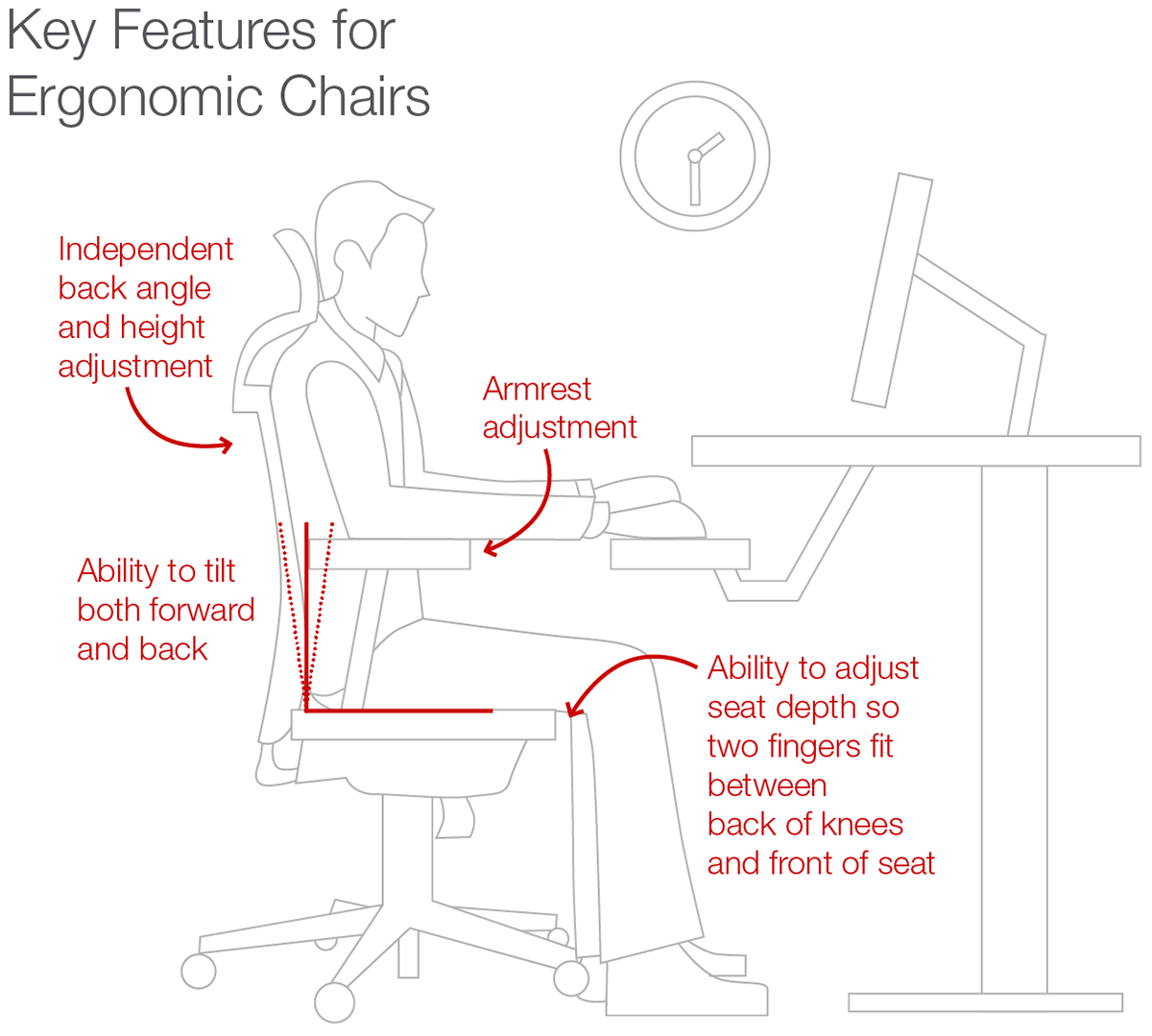Choosing the Best Ergonomic Office Chairs

You’ve heard the phrase thrown around a lot, but what does “ergonomics” mean when it comes to choosing an office chair? Ergonomics is the science of designing and adjusting items in order to yield maximum efficiency and safety in a work environment. Ergonomically designed furniture helps reduce the strain on different parts of the body caused by poor posture that, over time, can result in chronic-pain-type injury. When it comes to buying the right chair for your workspace, understanding ergonomics will help you make a healthier choice.
What to look for in an ergonomic chair
Many people assume that ergonomics translates into how comfortable a chair should be. In reality, ergonomics has nothing to do with comfort. In fact, truly ergonomic chairs and office furniture should encourage dynamic movement changing your position at regular intervals throughout the day.
Nick McElhiney of Ergonomic Evolution, a Colorado-based ergonomics education and consulting firm, believes that the best office chairs should be adjusted to an individual and encourage movement. “I want to encourage you to change your position throughout the day,” says McElhiney. Shifting in your seat and adjusting to more comfortable positions throughout the day actually helps to prevent muscle cramps, fatigue, and poor circulation.
“Having a good office chair can improve productivity,” says Linda Miller of EWI Works, a provider of occupational ergonomics solutions that offers training, assessments, product testing, and more. “But a chair won’t solve everything. Sitting is actually quite hard on the body.” When looking to purchase the best ergonomic office chair, there are several key factors that you should look for instead of choosing the most attractive or most comfortable chair:
- Pay it “forward.”
- Your chair should be able to tilt forward, not just back. This is ideal for keeping your pelvis tilted slightly forward. Make sure that your hips are slightly above the knees and that you avoid positioning your hips lower than the knees. Your feet should be supported either flat on the floor, or if your feet can’t reach the floor, look to other ergonomic products such as footrests.
- Make adjustments.
- Select an ergonomically correct chair with independent seat depth adjustment. Most chairs can be adjusted for a large percentage of people. If you have specific height or weight concerns, you can get a “petite seat” pan, or a specialty seat pan if you’re on the larger side. There should be at least two inches of clearance between your seat pan and your knees so the seat does not press into the back of your knees.
- Back support.
- Another item to look for in a good ergonomic chair is independent back angle adjustment and back height adjustment, based on your own personal preference of support.
- Look for specific features.
- When purchasing an ergonomic chair, your chair should offer a variety of important features, such as multi-tilt (forward and backward), height adjustability, independent deep back and deep pan angle adjustments, adjustable armrests, and sliding seat pan adjustments.

Tips from the experts: ergonomic seating
From standing desks to kneeling chairs to yoga ball chairs, both Miller and McElhiney agree that these chairs can do more harm than good if used improperly.
“Alternative chairs, such as a ball chair, are not optimum for an office environment. If an individual wants to try to use an alternative chair, it may be best to use it at home for short durations of time,” said Linda Miller. “They may feel that they’re getting good results at the gym by sitting on a ball chair. However, in office environments, individuals often start to round their back after sitting on this style of chair for hours at a time, leading to awkward back postures and discomfort.”
“People aren’t able to focus on tasks when using these types of devices,” offered Nick McElhiney. “Standing desks and workstations don’t solve the problem of reducing or preventing back injuries either. Although standing desks put you in a different position, you’re still sedentary and trading one set of problems for another.”
To mitigate the risks of back and muscle injuries incurred by sedentary habits, our experts offer several tips:
- Choose the right chair.
- “A lot of people buy chairs with their eyes and not their butts,” said McElhiney. “When they finally take the sit-test, they sit in the chair for 30 seconds or a minute, at best. They don’t think about the tasks they’ll actually be doing in that chair.” Miller echoed his comments, noting that “sitting in a chair for five minutes in a store isn’t a trial.” It can take three-to-five days to gain a better understanding of how a chair will work with your body. If your chair doesn’t suit your needs, Staples offers a 30-day return policy on all non-custom furniture, for any reason.
- Know how to properly adjust your ergonomic chair.
- “The most common mistake I come across in workplaces is that, typically, if someone does have a good ergonomic chair, they don’t know how to adjust it,” said McElhiney. Very often, individuals will sit too low or over-use the backrests on their chairs, weakening the back due to underuse of muscles. It may be a worthwhile investment to bring in an expert to measure you for an ergonomic chair, or to teach you how to adjust your seat.
- Adopt an open trunk posture.
- When sitting in your chair, opt for an “open trunk posture” that opens up the hips by keeping the hips over the knees. This reduces weight on the lower back and hips, transferring it to the legs and feet and moving the body into a more natural S-curve.
- Rotate positions.
- As McElhiney mentioned before, it’s important to continue to shift your position in your seat throughout the day to encourage better circulation and reduce cramping. However, if you’re also using a standing desk, it’s just as important to alternate between sitting and standing too. “Standing for long periods of time isn’t very good for the legs and back, either. It has to be part of a regular rotation,” noted Linda Miller. When using a standing desk, footwear matters, too: “Wear good, supportive footwear that cushions your feet when standing for several hours.”
- Take microbreaks.
- “Employers may think their employees aren’t working, but in actuality, we come back more refreshed and able to concentrate,” noted McElhiney. “Microbreaks actually improve productivity by reducing strain on our body and risk of musculoskeletal disorders. Linda Miller also advocates for short microbreaks, saying that “even with the best ergonomic setup, you still need to get up, stretch, or take a short walk every 30 to 45 minutes. I find that’s the best.”
- Adjust your peripherals.
- If you’re alternating between a standing desk and an ergonomic chair, make sure to adjust your computer monitor’s height accordingly. Your monitor should be at eye level. Flexible monitor stands can help, and some monitors also have height-adjustable pedestals. If your monitor is too low when using a standing desk, you lose the benefits of standing because your head and neck are put in a forward posture that defeats the purpose of an ergonomic workstation.




